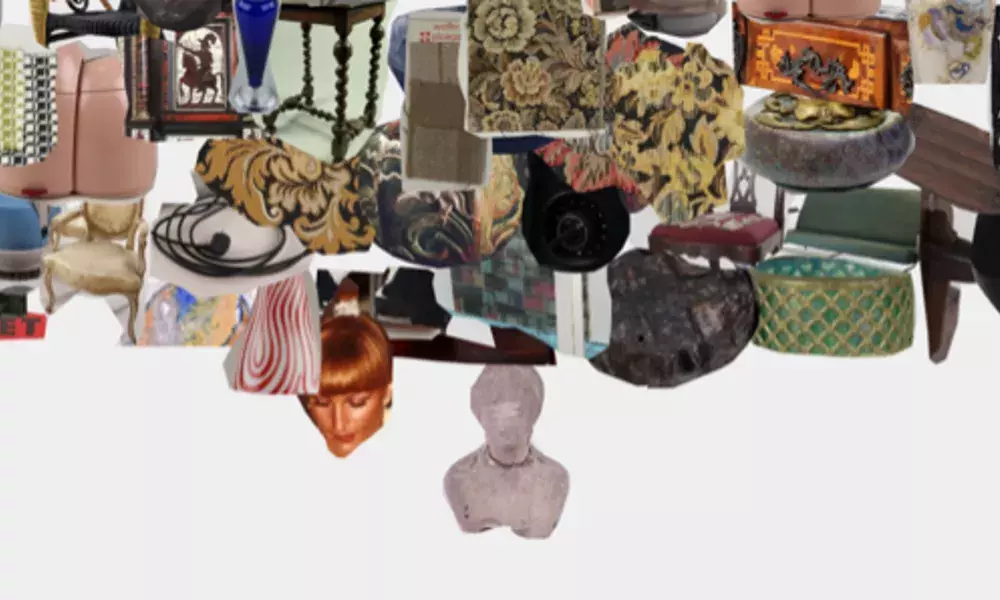
1. EXECUTIVE SUMMARY
The CoGhent project intends to repurpose digitised and digital born cultural data to facilitate the dissemination, reuse, and recombination of institutional cultural heritage data bringing in the contribution of different local communities with stories and artefacts to enrich, complete this city wide repository of cultural heritage data. In creating a multi-voiced platform the project sets out to promote social cohesion within the population of the city through a more open, accessible, rich, diverse and representative digital cultural heritage.
The project is in line with EU ERDF policy objectives focusing on open digital innovation, open access to culture, e-inclusion, community-based cultural services and education as well as similar technological, social, and participatory objectives at national, regional and local levels.
The last concluding year of the CoGhent project was dedicated to analysis of the different experimentations (the CoGhent Box testing the progressive development of the project in 3 successive city neighbourhoods and the Co-creation Fund, an open call for creative reuse of the 80 000 digitised cultural object and the open data technology to recombine them), to the discussion of their impact on the various cultural, social and technological dimensions of the project and, to the involvement of the multiple project’s stakeholder in order to ensure the sustainability of the project outputs and their out-scaling to other institutions and cities.
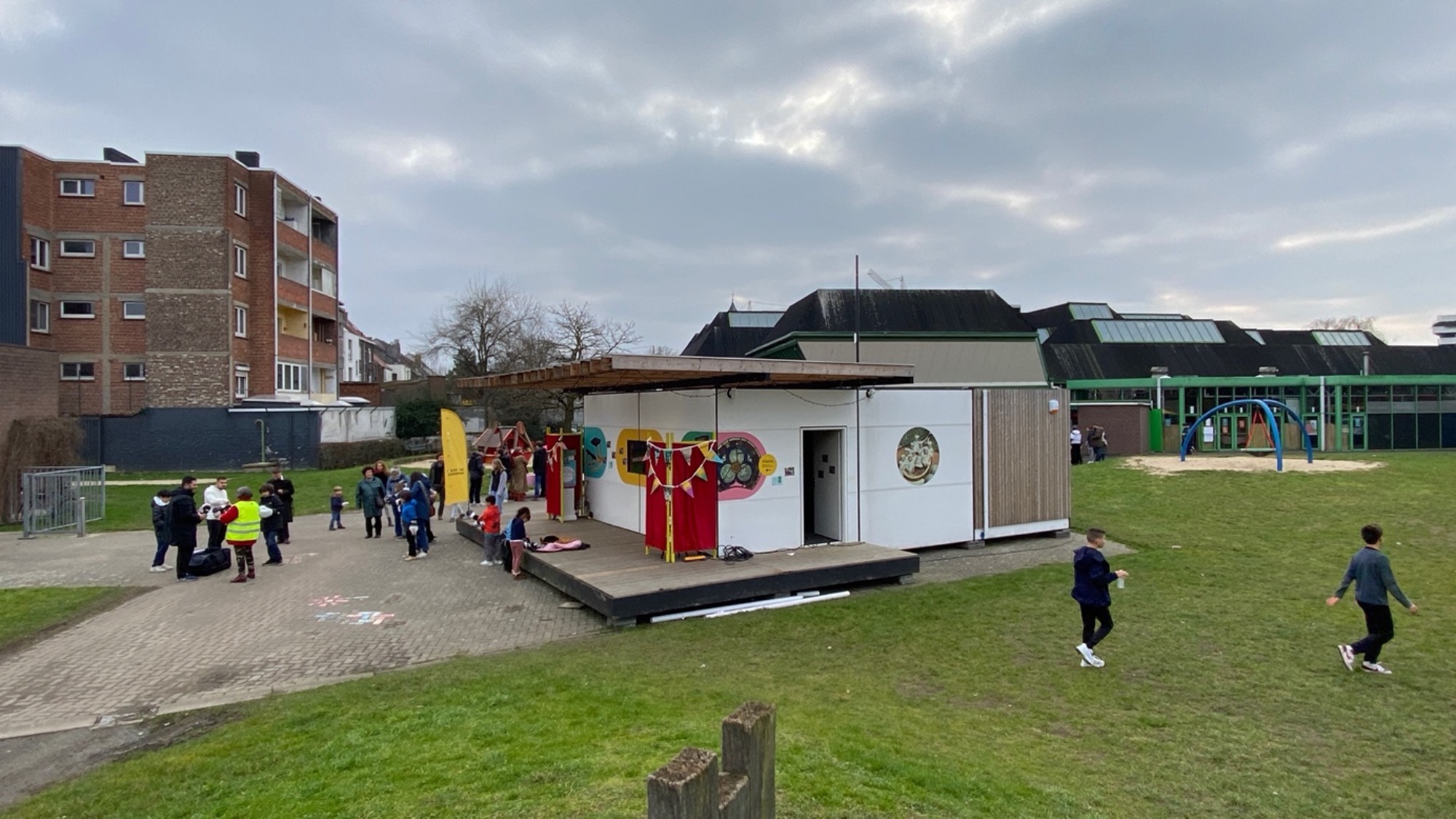
Last day of the installation of the CoGhent Box in Sluizeken-Tolhuis-Ham neighbourhood (photo credit: François Jégou)
CoGhent appeared to be based on 2 parallel tracks of projects. On the one hand, a top-down track: tech developments to make the 5 city cultural institutions’ collections digitally available and reusable. On the other hand, a bottom-up track: an effort to reach out to citizens and to enrich city collections with grassroots cultural heritage. Both tracks seem to have stayed apart with lack of synergies between them.
The experiments made along the project and their impact assessment pointed that neighbourhood inhabitants do see an interest in multicultural heritage that bring more connectivity between them, interactions across communities, belonging to the territory, etc. and confirm CoGhent’s courageous hypothesis on such a sensitive topic as social cohesion now in Belgium, in Europe and beyond.
The distributed management adopted by the CoGhent project coordination team reveals to be rather efficient to manage a large and heterogeneous consortium and showed relative resilience to the Covid crisis. It also shows difficulties to align all partners around the same clear goals, to balance autonomy in tasks and tight collaboration, to dedicate enough time to set a shared understanding of common goals in a relatively short 3 years UIA timeframe. More scenario building and forward-looking activities at the beginning of the project could have helped alignment of stakeholders, strategic conversation on project sustainability and up-scaling.
Impact of the project should be observed in the long run and at a more systemic level, looking at the increased connectivity across the city and the related potential of conducting integrated approaches. New ways of working emerged in the project, consolidated with the creation of a “city labs”.
The sustainability of the features developed by CoGhent is critical in times of shrinking public budgets. The CoGhent Box tech infrastructure will be displayed for record in the city Design Museum. The CoGhent platform revealed to be mainly focused on downstream reuse/recombination of cultural institutions collection through successful creative process such as the Co-creation Fund rather than on upstream participative enrichment of these collections with grassroots material collected from the city populations and neighbourhood history. Some of the data management technology blocks are likely to be reused at Flemish government level.
2. PROJECT PROGRESS
2.1 WHAT HAS HAPPENED WITH THE PROJECT SINCE ITS END DATE
CHALLENGE ADDRESSED
More than one core challenge, CoGhent is addressing a series of issues and opportunities concerning cultural heritage, its wholeness, representativeness, accessibility, dissemination through repurposing, etc. in the current trend toward open digital culture.
In particular, the project intends to address 2 parallel and interwoven streams of issues.
On the one hand, citizens have few means to contribute to cities’ cultural heritage presented in cultural institutions. In particular, popular history, grassroots’ knowledge, successive flows of migration tend to be missing in territories’ cultural heritage. However, culture has an enormous potential to improve social cohesion. All local communities should find themselves, their actions and life represented and worth to be preserved as common cultural heritage.
On the other hand, digitization of cultural data in progress among museums, libraries, and cities’ cultural institutions struggles to be appropriated and reused by citizens. In particular, a lack of common approaches between cultural institutions, of open and accessible platforms hinder the potential to reach out to new and larger parts of the population.

User interface showing visualizing the links between objects of the collection (photo credit: François Jégou)
Social cohesion and social inclusion through digital culture?
The CoGhent project intends to merge these two streams of issues into an opportunity that draws on the huge potential of digitization to stimulate an open access to cultural heritage. On the one hand, digitization of cultural data is likely to be an opportunity to unlock cultural capital from the institutional silos where it is currently kept, to make it widely remotely available while stimulating multiple possibilities for its re-use and creative recombination.
On the other hand, the same digitization processes show a great potential to open up, connect and organise the richness and diversity of vernacular culture, testimonies and artefacts coming from the city populations and therefore improve social cohesion and social inclusion.
Bridging between these streams of challenges and opportunities, CoGhent aims to increase social inclusion and cohesion in the city, supporting the cultural heritage of the city to integrate and evolve towards the opening of cultural digital data.
SOLUTION IMPLEMENTED
CoGhent project built the necessary IT infrastructure to enable easier and wider access to institutional culture heritage, to facilitate its reuse and recombination on the one hand. On the other hand, it aimed to enable self-contribution from the population to enrich and complete the cultural heritage preserved and disseminated by cultural institutions.
In concrete terms, CoGhent has built an open data platform and a first instantiation of it in a mobile infrastructure called The CoGent Box that intends to work as the “touch point” and first physical demonstrator of this new digital cultural data city service for all actors of the city and the public at large.
The CoGent Box was intended to be the result of a co-design process between the project’s stakeholders and the population of the city. It should allow citizens to both access digitally and enjoy the content currently kept in closed repositories in cultural institutions, as well as capture citizens’ stories and memories to complete and diversify Ghent’s cultural heritage collections.
CoGhent infrastructure has been experimented with the mobile CoGent Box and fine-tuned it in 3 pilot neighbourhoods throughout the project. It will be included permanently in the Design Museum Gent.
The CoGhent project intended to explore and experiment the evolution of cultural institutions of the city and beyond as open and inclusive “cultural third places”, likely to improve the access and participation to cultural and recreational services, foster intercultural dialogue, enable populations from all cultures and backgrounds to find space and to contribute to.
PROGRESS MADE
LEADERSHIP
The project benefitted from a smooth and careful coordination effort but still faced distributed management problems within an heterogeneous partnership, lack of clear common goals shared among parties and active recognized leadership able to arbitrate divergences. Political support from 5 city Alderman at the start also tends to decline, shifting attention from a transversal project to their respective administrative silos facing successive crisis and financial cuts.
PUBLIC PROCUREMENT
Competences for the realisation of the project were already included in the initial partnership of CoGhent and procurement which mostly focused on the acquisition of the hardware for the realisation of the Box prototype, runs smoothly through internal IT procurement processes and the facilitation of the CoGhent financial coordinator. No major procurement process took place in the last 2 years outside minor catering or dedicated interventions for events or specific actions.
ORGANISATIONAL ARRANGEMENTS WITHIN THE URBAN AUTHORITY
The distributed management adopted by the CoGhent project coordination team reveals to be rather efficient to manage a large and heterogeneous consortium and showed relative resilience to the Covid crisis. It also shows difficulties to align all partners around the same clear goals, to balance autonomy in tasks and tight collaboration, to dedicate enough time to set a shared understanding of common goals in a relatively short 3 years UIA timeframe, simultaneously avoiding participation fatigue from stakeholders.
PARTICIPATIVE APPROACH FOR CO IMPLEMENTATION
CoGhent participative stakeholder approach was a particularly tough challenge working with a very large and heterogeneous partnership. Despite some issues, the distributed open management of the partnership revealed to be a great progress in particular for the integrated collaboration between the city administration’s silos.
The motivation of the city cultural institutions to take part in CoGhent and particularly their motivation to reach out to citizens and to enrich city collections with grassroots cultural heritage was started with a first batch of 300 objects on the CoGhent platform.
MONITORING AND EVALUATION
The evaluation framework foreseen by the CoGhent project is intended to capture qualitative effects of the projects, collecting voices of practitioners and not only experts, building narratives to capture impacts that quantitative processes wouldn’t be able to capture. Indirect effects of the project should be observed in the long run and at a more systemic level, looking at the increased connectivity across the city and the related potential of conducting integrated approaches. New ways of working emerged in the project, consolidated with the creation of a “city labs”.
COMMUNICATION WITH TARGET BENEFICIARIES AND USERS
CoGhent developments open the richness of the city cultural institutions’ collections to local cultural creatives, facilitating the reuse of the institutions’ collections, giving them visibility, fluid thematic browsing, good digital quality, cleared copyright, etc. Nevertheless, exploration and appropriation of the opportunities offered by CoGhent is needed to reflect in the quality of the recombination of the digitised cultural data made available.
The important effort of CoGhent to listen to unheard voices and collect local cultural heritage objects and stories happened to be mostly promoted on the project social media streams echoing FaceBook groupes of large pre-existing communities of local cultural heritage amateurs and slightly blurring this grassroots dimension on the CoGhent developed platform.
UP-SCALING
The CoGhent Box tech infrastructure will be displayed for record in the city Design Museum. The CoGhent platform revealed to be mainly focused on downstream reuse/recombination of cultural institutions collection through successful process as the Co-creation Fund rather than on upstream participative enrichment of these collections with grassroots material collected from the city populations and neighbourhood history. Some of the data management technology blocks are likely to be reused at Flemish government level. More scenario building and forward-looking activities at the beginning of the project could have helped alignment of stakeholders, strategic conversation on project sustainability and up-scaling.
EXAMPLE OF SIGNIFICANT ACTION
After the CoGhent Box, a second stage of experimentation, the CoGhent project implemented a Co-creation Fund which encouraged citizens, companies and artists to interact with the newly digitised collections by exploring ways in which these collections can be used. The fund not only sought to stimulate creative applications of the technology developed during the project, but also tackle the issue of unpaid work in the cultural sector. In this way there would be more guarantee that a wider amount of the population would participate, not only the ones with time and financial stability. Two grants were made over the course of the project: the first for “creative projects” which reused the digital collections made available through the new portal developed, the second for “technological projects” which made use of the digital infrastructure. The motivation behind these grants was to test a process of recombination of digitised open cultural data that don’t simply remain in digital versions of museums but disseminate past museum walls into the neighbourhoods of the city.
Below are some examples of the first Co-creation Fund.
LINKED ARTEVELDESTAD
The project “Linked Arteveldestad” intends to make a navigation app that combines data from the collections with points of interest in the city combined with other open datasets, such as mobility data from Openstreetmap. The idea is that based on your personal preferences, this app gives you a route that sends you to a museum, a point of interest, etc
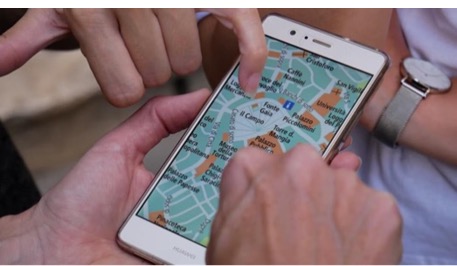 « Linked ARTeveldestad - IMEC / IDLab vzw » project selected by the CoGhent Co-creation Fund combines data from the collections with points of interest in the city on a map attracting users to the Ghent cultural institutions (photo credit: Linked ARTeveldestad - IMEC / IDLab vzw)
« Linked ARTeveldestad - IMEC / IDLab vzw » project selected by the CoGhent Co-creation Fund combines data from the collections with points of interest in the city on a map attracting users to the Ghent cultural institutions (photo credit: Linked ARTeveldestad - IMEC / IDLab vzw)
COLLAGE VAN GENT
Collage van Gent is one application that will make a participatory collage of the collections. Building on the current trend of making collages of visual material collected on the Internet, the application allows users to access local cultural heritage likely to stimulate local populations and progressively build a collective assemblage of their different memories.
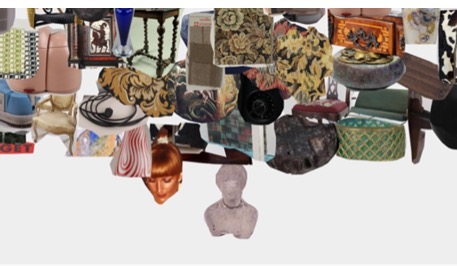 « Collage van Gent - Ctrl Alt vzw » project selected by the CoGhent Co-creation Fund proposing a participatory collage of elements coming from Ghent’s collections (photo credit: Collage van Gent - Ctrl Alt vzw)
« Collage van Gent - Ctrl Alt vzw » project selected by the CoGhent Co-creation Fund proposing a participatory collage of elements coming from Ghent’s collections (photo credit: Collage van Gent - Ctrl Alt vzw)
MESH VZW / OPEN DESIGN COURSE
“Mesh vzw / Open Design Course” is a project by a graphic designer who has been creating stylized drawings and colour schemes based on objects from the collection, and now he's giving workshops in design schools where the idea is that students make new derivative works reusing patterns from the collections.
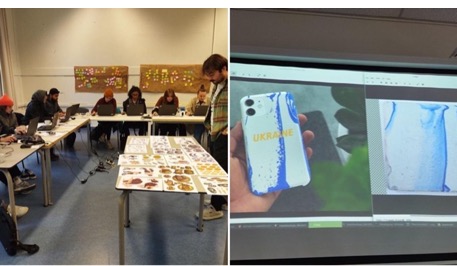 « Re-use it - Mesh vzw / Open Design Course » project selected by the CoGhent Co-creation Fund organizing design workshops based on reinterpretation of collections patterns (photo credit: Re-use it - Mesh vzw / Open Design Course)
« Re-use it - Mesh vzw / Open Design Course » project selected by the CoGhent Co-creation Fund organizing design workshops based on reinterpretation of collections patterns (photo credit: Re-use it - Mesh vzw / Open Design Course)
1000 JAAR GENTSE KOOP
“1000 Jaar Gentse koop” project (1000 years of buying locally) is developed by an organisation that promotes buying locally. They wrote a project making mini pop-up exhibitions in buildings that used to house businesses that are no longer there.
 « 1000 jaar Gentse koop - Gentsekoop » project selected by the CoGhent Co-creation Fund focusing revival of former commercial businesses (photo credit: 000 jaar Gentse koop - Gentsekoop)
« 1000 jaar Gentse koop - Gentsekoop » project selected by the CoGhent Co-creation Fund focusing revival of former commercial businesses (photo credit: 000 jaar Gentse koop - Gentsekoop)
SCHROOT HOOP
“Schroot Hoop” is based on storytelling. It's a word joke that means both “trash heap” and “trash hope”: participants are going to save objects that are deposited at the city dump, record the story about these objects and try to relate them to objects in the Design Museum of Ghent…
 « Schroot / hoop - De Zieke Steur, aifoon, Relaas » project selected by the CoGhent Co-creation Fund focussing objects saved from the city dump and connecting them to objects in Ghent’s collections (photo credit: Huis van Alijn 2, Michiel Devijver (right) Poëzie van de industrie, Karolien Deman (left)
« Schroot / hoop - De Zieke Steur, aifoon, Relaas » project selected by the CoGhent Co-creation Fund focussing objects saved from the city dump and connecting them to objects in Ghent’s collections (photo credit: Huis van Alijn 2, Michiel Devijver (right) Poëzie van de industrie, Karolien Deman (left)
STR.AAT
STR.AAT is a documentary about the evolution of the street of Ghent using images from the archive and combining them with stories about daily life in Ghent, showing how the city has changed throughout the decades.
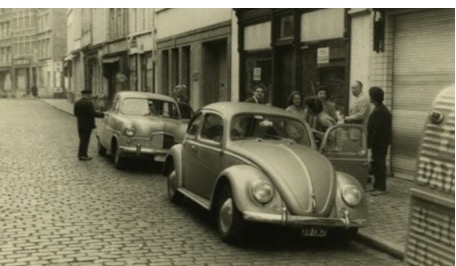
The car in front is a Volkswagen Beetle (1957-1960), the one behind a Ford Consul (photo credit: collection Huis van Alijn, under copyright, non-commercial use authorised)
VROOM VROOM
Vroom Vroom is a project in the Malem neighbourhood which seeks to evoke the creativity that was present at the time and the numerous shops that used to fill the neighbourhood. By involving the inhabitants and temporarily filling the store windows and placing signs on the facade the idea is to revive these commercial structures.
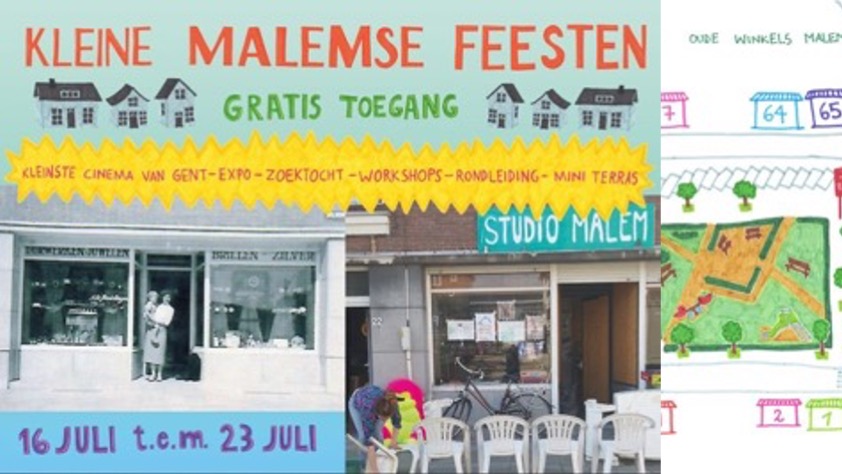
Visualisations elaborated to map and pictures the shop atmosphere in Malem (photo credit: Vroom Vroom is a project)
INTERACTIVE PHOTOBOOTH
This interactive Photobooth will tell you “Which famous Ghent persona would you be?”. By developing a creative AI and placing it in a physical photo booth this project creates an interaction between museum visitors and digitised collections by transposing their face onto a historical artefact. A fun way to question the cultural repository and whether it truly represents Ghent's population …

Using a deepfake AI (gener8.ai) a persons photo is taken in the photo booth and combined with a painting or statue from CoGhent collection.
2.2 WHAT IS THE PROJECT’S PLAN FOR LONG-TERM SUSTAINABILITY
SUSTAINABILITY OF THE PROJECT
“The technical infrastructure developed for the CoGhent Box will be hosted in De Krook new city central library waiting to be installed in the new wing of the Design Museum Ghent, commented Nele Samyn, and the wonderful platform with up to 80 000 digitised cultural objects will stay online with basic maintenance”. Before discussing up-scaling of the project, the question of the sustainability of the developed features is critical in times of shrinking public budgets.
The CoGhent Box was the first instantiation of the project concept. Achievement and issues have already been discussed in previous COGHENT JOURNALS #1 and COGHENT JOURNAL #2 mainly a “mini-museum” reaching out Ghent’s neighbourhood and populations far from city cultural institutions; difficulties in attracting visitors and engaging participation and interaction through the interface design proposed; confirmation of the interest from the citizens to liaise with local cultural heritage and deepen their roots in their neighbourhood history, etc. The CoGhent Box artefact was the first level of experimentation of the project now overtaken by Co-creation Fund outputs that constitute a second level of more advanced and distributed experimentations of the project. Re-integrating the CoGhent Box technological infrastructure into the city Design Museum seems a contradiction both with the project effort to reach out to places and populations far from cultural institutions and with the CoGhent Box design that is probably not a lighthouse neither in terms of UX design nor in terms of appropriated spatial architecture. It will be at least the evidence of a first controversial iteration of the ambitious CoGhent project and for that it probably has its place in a museum in a traditional sense of the term.
The CoGhent platform then, with the 80 000 digitised objects and the IT infrastructure that enables third parties to reuse them in new creations or applications is certainly the main vivid asset that will remain from the project.
The so-called 6th collection stream aiming at enriching the official collections of city cultural institutions with grassroots objects and stories proved to be an interesting intuition with a first batch of 300 objects on the platform. The process of collecting stories and objects from the various city populations and neighbourhoods to be maintained would require an important human effort (i.e. scouting for pertinent sources, collecting interviews, analysing large quantity of material, selecting and editing the essence of it with strong sociological or historical value, etc. ) to maintain as it is hardly supported by the technology developed by the CoGhent project (mainly focused on downstream reuse/recombination rather than on upstream participative collection).
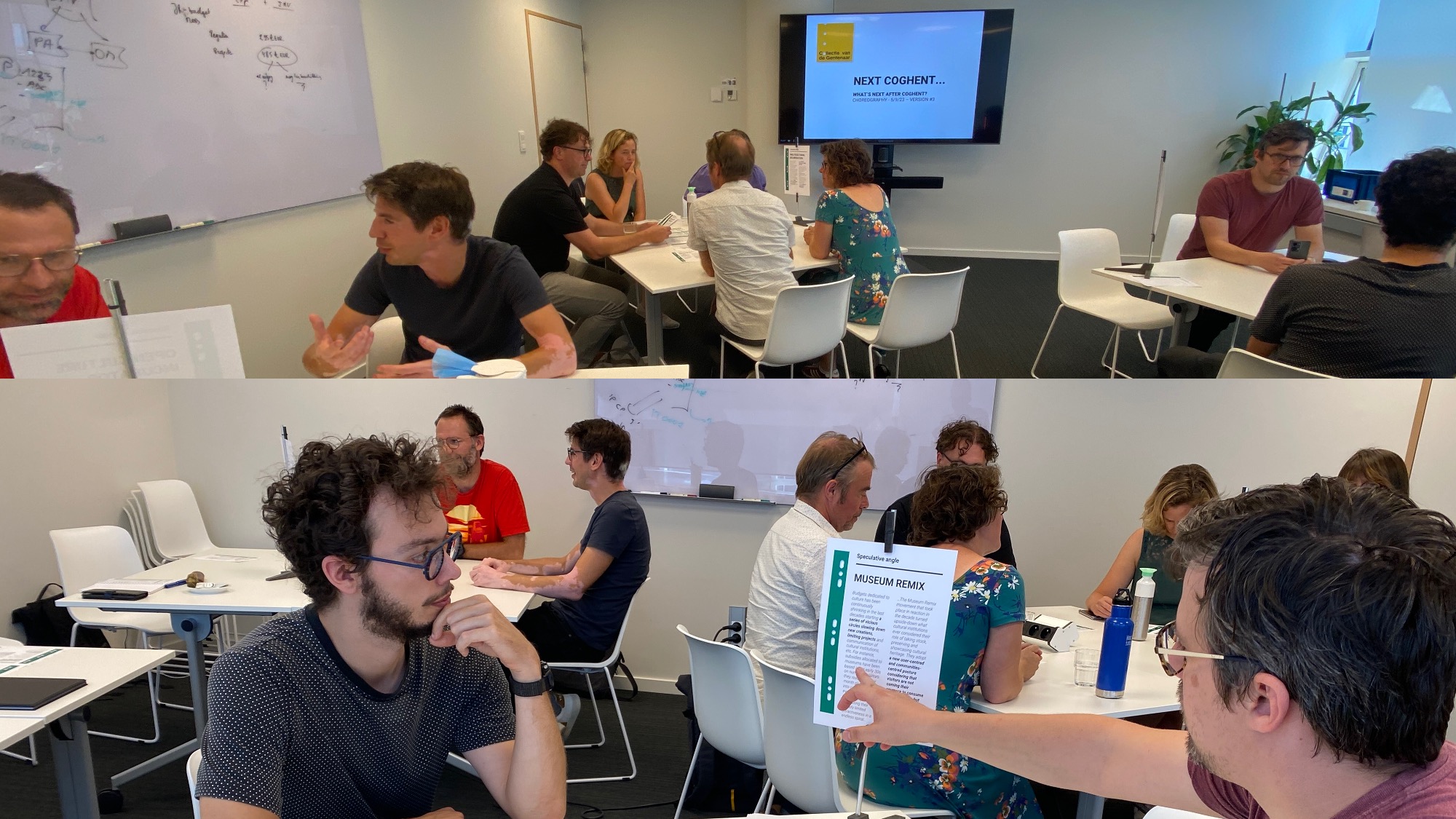 NEXT COGHENT workshop organised with the participation of members of the CoGhent project team and external city civil servants (photo credits: François Jégou)
NEXT COGHENT workshop organised with the participation of members of the CoGhent project team and external city civil servants (photo credits: François Jégou)
LOOKING FORWARD FROM THE BEGINNING…
The 5 museums and city archives digitised collections will remain available on a joined platform for reuse and recombination with an advanced technological infrastructure (Data Asset Management System, Linked Data Event Stream, etc.). The Co-creation Fund process boosting the cultural creatives arena to engage with digitised cultural heritage started the momentum of creative reuse of digitised cultural data provided that some follow-up funding will be invested to support it.
“Who will pay for the sustainability of the project afterward should be known in advance” commented Pieter-Jan Pauwels. But it is unlikely that stakeholders would commit to provide financial support nearly 4 years in advance to support the hypothetical results of an ambitious project that hasn’t started yet… As discussed in Web Article #5 COGHENT: STARTING THE NEXT STEPS…: “Too often, partners have committed themselves to a specific service for which they have been contracted, and once their services have been completed, they tend to disengage from the project, or even never really feel committed beyond the services for which they had signed a contract...". More time should probably be invested in forward-looking activities and strategic thinking at the beginning of UIA projects.
Inspiration could come from the private sector mimicking start-up dialogue with investors based on sound projection efforts and business plans to estimate the viability of an initiative in the long run beyond political declarations and informal partners’ engagements.
Another inspiration could come from foresight practices, building tangible scenarios imagining what could happen after the project, involving stakeholders in projection activities on their roles and possible engagements, describing precisely scenarios content, articulations, probability of occurrence, possible wild cards, etc. This kind of activity was proposed at a small scale during the NEXT COGHENT workshop. As discussed in Web Article #8 NEXT COGHENT : SEARCHING FOR COGHENT’S FOLLOW-UP SCENARIOS by Sofie Rottiers, community worker at the city of Ghent involved in the CoGhent team working on the field, “Such an exercise should have been organised at the beginning and the end of CoGhent”. Benefits are to force partners to jointly imagine tangible and precise outputs of the project facilitating their convergence and alignment and to open between all stakeholders before starting the project a large goals- and impact-focused conversation.
3. GENERATED KNOWLEDGE
3.1 LESSONS LEARNED
LEADERSHIP
HETEROGENEOUS FORMS OF STAKEHOLDERS’ MANAGEMENT
“A perfect work of coordination but a lack of strategic decision in the management of the project.” For Nele Samyn, Communication Officer of CoGhent, the project benefitted from a smooth management and careful articulation of the stakeholders. Line Ostyn, Project Coordinator describes her job as being “part of the people with a more neutral role, that makes sure the conversation pursues beyond problems or tensions. Because the project must be brought to a successful conclusion, even if there are disagreements. ”
But good coordination doesn’t ensure the leadership of the project. Or more precisely, CoGhent’s coordination struggled with a leadership that reveals to have different forms across a large and heterogenous partnership as in the CoGhent project. For instance, remarks Nele “the leadership within the group of cultural institutions involved - the 4 city museums and city archives - was not clear. Nobody was entitled to act as spokesperson for this group of stakeholders… Halfway through the project, museums tended to stop playing the game. They followed their own different tracks making it more difficult to keep alignment with the goals of the CoGhent project”
Line Ostyn, concluded: “It’s maybe a naive idea but it would have been different if someone or a group of people would have been able to take “real leadership” of the project, ideally a small club based on the Directors of city administration but they hardly took part in the steering group…”. Line is pointing to the key issue of keeping a balance between distributed management based on collective intelligence and participative decision-making processes on the one hand and, on the other hand centralised leadership based on charismatic lead and final top-down arbitration especially when considering a new heterogenous partnership and a relatively short 3 years framework project…
CONTINUITY OF THE POLITICAL SUPPORT…
On paper, the steering of the project seems perfectly organised, explains Pieter-Jan Pauwels from District09 who with Olivier Van D’huynslager from AGB Art and Design were the 2 ideators of CoGhent. The project involved 5 city Aldermen and their respective services including City Management, Policy Participations, Data and information, Social cohesion, and Culture. The Innovation area was given the “power of authorization”, an apt, rather neutral position to lead the transversal partnership.
“There was lots of buy-in from a political point of view at the start of CoGhent, explains Pieter-Jan, but administrative silos are still an important issue”. Different Aldermen have different goals and responsibilities in their respective domains. CoGhent is an integrated project and no one can stand to defend it because it’s transversal to many areas.
“Where has the enthusiasm from the beginning of the project gone ?” questions Line Ostyn. There are certainly many reasons for that among which the progressive decline of the initial catalysing effect of the announcement of UIA funding on city services and administration management. Other reasons were: the lack of senior leadership except from the department of Culture; the multiple crises (Covid19, Ukraine…) hitting the course of the project and shifting attention of decision makers of Ghent and increasing financial difficulties; lack of buy-in from MUA and higher level of governance, etc. “The project line is less matching with the updates of the political line of the city, conclude Pieter-Jan, we should avoid in future projects too many intermediary layers between the project core team and the political leadership”
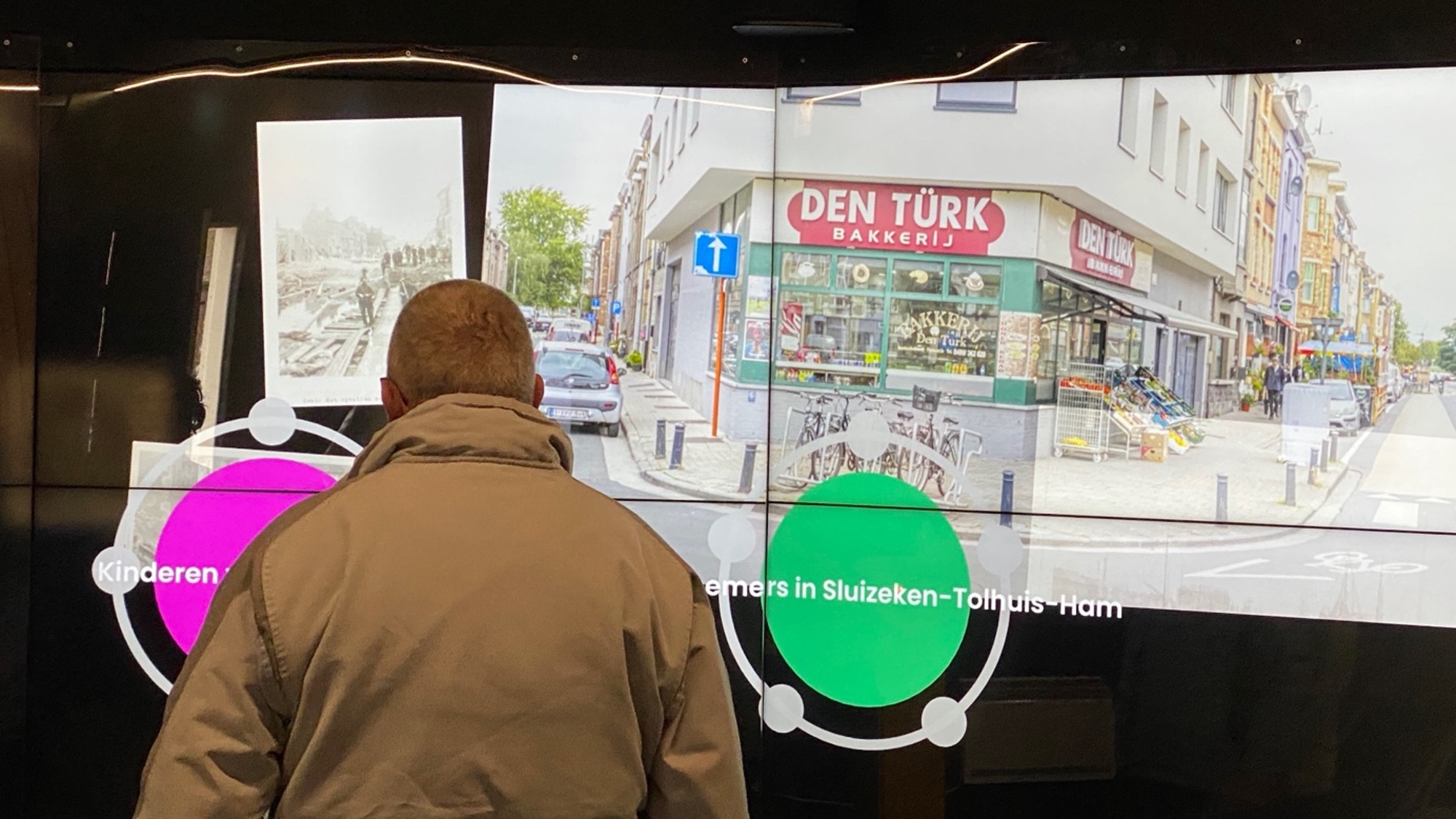
A story from Sluizeken-Tolhuis-Ham neighbourhood based on the Collections presented in the CoGhent Box (photo credits: François Jégou)
PUBLIC PROCUREMENT
Procurement has not been assessed by project stakeholders as a particular challenge for CoGhent and nothing determinant took place in terms of procurement since the first year of the project. We copy here for the record the summary from the Journal #2:
The rich initial setting of the CoGhent partnership already secured all the competencies necessary for the project and most of the procurement issues concerned the acquisition of the hardware material for the construction of the CoGhent Box prototype. This hardware was not seen as a strategic aspect to influence local economy or city stakeholders’ ecosystem and was therefore achieved mostly through existing IT procurement canals and frameworks of the city. This process took place before the sanitary crisis and was not particularly impacted. No major procurement process took place in the last years outside minor catering or dedicated interventions for events or specific actions
ORGANISATIONAL ARRANGEMENTS WITHIN THE URBAN AUTHORITY
COORDINATING DISTRIBUTED MANAGEMENT
“As coordinator, reports Line Ostyn, if you take over certain tasks then it’s difficult because stakeholder have to take it back… sometimes it’s better not to interfere so that stakeholders stay responsible and feel in charge of their tasks”
As discussed in Journal #2, this form of open management allowed the CoGhent consortium to manage interaction with a large number of stakeholders. This distributed management also revealed to be quite resilient to the Covid crisis: the autonomy left to each project's partner allowed them to go on with their tasks despite successive periods of lockdown. The drawback of this relative autonomy is that stakeholders always tend to shift away from the project goals, refocus on their interests and their own specific agendas. Distributed open management requires a very strong stakeholder’s alignment with common project’s goals at start. A smooth but firm management, with regular moments of realignment between stakeholders, strong and charismatic leadership to keep the momentum and fight the partnership fatigue caused by the difficulty of a large partnership coordination process…
CLEARER SHARED AND ACCEPTED GOALS…
“Neighbourhood workers used to go into the neighbourhoods. The cultural institutions weren't and it wasn't part of their job. So it was difficult to find a common goal for everyone to strive for” reports Line Ostyn, stressing the issue of aligning each stakeholder's specific agenda. Dealing with a variety of agendas is a normal situation when managing an integrated project aiming at bringing together diverse actors from city policy participation services, to open data tech development, and cultural institutions. But pushing forward such a project is only possible when all players agree on clear and common goals.
“Some goals from the project were already unclear in the initial proposal, " says Line Ostyn. At the beginning stakeholders were waiting for clarification and a lot of time was needed to build alignment between them”. This time-consuming stakeholder alignment process is the tribute to pay for setting up an efficient open management. The Covid crisis which imposed distant collaboration, verbal-only exchange and low “social bandwidth” did not help. Heterogeneous actors with no previous experience of working together would have needed longer and more progressive collaboration processes to “feel” each other, adopt the same vocabulary and build constructive empathy. “In the cultural sector for instance, reports Line Ostyn, people tend to say things in very abstract terms which make it difficult for more pragmatic profiles to speak out about divergence in goals. We lost time before realising differences in alignments"
PARTICIPATIVE APPROACH FOR CO-IMPLEMENTATION
COMING BACK FROM THE EXPERIENCE OF A LARGE CONSORTIUM OF HETEROGENEOUS ACTORS…
“It’s rather new in Ghent to see such a strong collaboration between so many of the city’s departments, report Nele Samyn, from the point of view of integrated approach within city administration, CoGhent is seen as a very positive result”
As a reminder, CoGhent is an ambitious project involving a large number of stakeholders. Not less than 7 different city administration services were collaborating including Policy Participation Service, Communications Service, International Networking and Funding, Data and Information Service, Social Cohesion and Urban Well-Being Service, Department of Culture, Sports and Recreation Staff. 5 Cultural Organisations: Ghent Archives, Design Museum Gent, Industry Museum Gent, Huis van Alijn, STAM), District09, meemoo Flemish Centre for the Archive, Ghent University and 5 cultural creative private companies and NGOs (iDrops; Studio Dott; Inuits; Fisheye; Chase Creative). Difficulties mentioned above with the coordination of this very large partnership (i.e. lack of clear common goals shared among parties, distributed open management struggling to align heterogeneous actors, active recognized leadership able to arbitrate divergences missing, etc.) doesn’t mean that the result of participative stakeholder approach was deceiving but rather shows that the challenge of co-implementation was particularly high. Especially when considering the difficulties to break administrative silos and implement a large integrated approach.
“In a way, CoGhent has suffered from the fact that it wanted (and succeeded in) an ambitious multi-stakeholder project” states Nele Samyn.
POSTURE OF MUSEUMS AND CITY ARCHIVES IN THE PROJECT…
About 80 000 objects have been digitised during the CoGhent project and made available on the digital platform developed during the project. Among these 80 000 digitised objects, about 79 700 are objects coming from the “5 collections” of the participating city museums and city archives. Which means that the “6th collection”, the one which harvested grassroot stories and memory objects from the neighbourhoods’ populations, is reduced to a first batch of about 300 items…
This result needs to be discussed in light of what Christine Deweerdt, Director of STAM, Ghent city museum stated at the beginning of the project: “[…] our collections are rich of the Belgium culture, but what about Turkish, Bulgarian and all other cultures that made what Ghent is today?”. This “6th collection” seems rather poor compared to the massive presence of the “5 official cultural institutions' collection”. “The ability to add photos and stories during the testing pilot was a total period of 9 months, explains Pieter-Jan Pauwels. The different museums had decades of metadating and good pictures. It is a core part of their role as preservers.” It was then much easier for them to contribute massively to the digitised collections.
Another important point has to be taken into consideration. As Christine Deweerdt recalls: “Museum's task is to discuss which object has sufficient historical, artistic, sociological, etc. cultural heritage value and to preserve it”. Not all grassroots objects and stories collected have enough of the described value, and the 300 that were integrated in the CoGhent platform were de facto recognized as cultural heritage. The batch of 300 grassroots’ objects is a first step towards a more fair and balanced integration of all populations as recognized stakeholders of the city and the increase of city’s social cohesion is reduced. In parallel, the CoGhent’s effort for cultural institutions to reach out to citizens in 3 different neighbourhoods stopped with the end of the CoGhent project and the reintegration of the mobile installation in the new wing of the Design Museum in the city centre.
Beyond installing a better balance between top-down and bottom-up streams of cultural heritage, between reaching out to citizens and perpetuating museums’ access barriers, the motivation for museums and city archives for participating in CoGhent seems mainly the creation of the city’s cultural institutions’ digital catalogue hosted on a joint platform.
MONITORING AND EVALUATION
OUT OF ONLY NUMBERS…
“Project accountability and justification of the money spent by quantitative impact measurement is increasingly important for large innovation projects such as the ones financed by UIA,” explains Bas Baccarne, from Ghent University and involved in the CoGhent impact assessment process.
The project proposal was written as experimental research. This allowed a broader assessment and a more holistic approach, as well as give more room for interpretative research and not remaining solely focused on numbers.
For example, the first CoGhent tech hackathon took place at STAM, Ghent city museum. People working there could experience a new creative session format. They acknowledged that the process was also hacking the institution, questioning how collections should be formed, assembled… One of the STAM employees interviewed remarked “how it opened their mind and demonstrated how to work differently”
“Impact research is driven by narrative, adds Bas. Practitioners’ voices are also considered. It would not have been possible to capture these weak signals of change with only a quantitative approach”

Example of activity organised with the local population picturing the multicultural social cohesion goal of CoGhent project (photo credit: Collections of Ghent promotion movie https://www.youtube.com/watch?v=TdfsnlRBJSY)
EFFECTS AT NETWORK LEVEL AND ON THE LONG RUN…
“5 M€ an expansive needle, the impact should be searched beyond what the project achieved” commented Bas Baccarne. He uses the metaphor of Chinese acupuncture, in which an action at the local level (the needle) intends to provoke an effect at a systemic level (the recovery of the patient). Similarly, the CoGhent project should be seen as a needle activating cultural processes with the intention to catalyse much broader effects on social cohesion between communities or on collaboration between local stakeholders.
How do you appreciate the levels of change? “You should consider 3 dimensions, continues Bas, network effects at the level of the ecosystem, the retention, anchoring changes at policy level, and consolidation of changing ways of working”. Following this model to read the different effects of CoGhent shows firstly that the large collaboration process initiated by the project across very distant types of stakeholders increased the « network density »: more nodes are connected, in other words, more people are in contact with more people, take part in advisory committees, etc. The connective capacity of the city increases the likelihood of conducting more integrated actions and policies.
People are more connected, but they leave their professional positions, many elements of change affect the ecosystem and the systemic effects of such project tend to vanish if they are not anchored in new administrative processes or news policy instruments. The CoGhent instantiation of a Cultural Lab consolidated the emergence of a “StadsLab”, a city lab as a tribe-like place of interdisciplinary exchanges, convergences of local fast-movers outside the radar of very hierarchical structures, experimentations and innovative developments.
“Appreciating the effects of change of a project like CoGhent requires time” add Pieter-Jan Pauwels. Barriers to change are very often human barriers: routine practices, lack of culture of collaboration, lack of flexibility in institutions… For instance, the projects emerged from the Co-creation Fund process (see above in 3.2. Examples of actions) may appear as light techy applications of the CoGhent infrastructure. Considered in the long run, they are the start of conversations and processes to warm up to and familiarise with the new opportunities offered by open cultural data. “The level of innovation needs time to change the cultural creative ecosystem” .
COMMUNICATION WITH TARGET BENEFICIARIES AND USERS
OPENING THE RICHNESS OF CULTURAL INSTITUTIONS TO CULTURAL CREATIVES?
CoGhent makes media from city museums and archives more accessible to so-called cultural creatives. This achievement is aligned with the initial goals of the project: the aim of CoGhent was to open cultural data at least of digital versions of objects kept in cultural institutions' stocks. It facilitates the reuse of these objects giving them visibility, fluid thematic browsing, good digital quality, cleared copyright, etc., when all that normally requires lots of time-consuming administrative procedures.
The benefits offered by CoGhent give access to the richness of the cultural institutions collections compared to the reduced number of media available online (museums’ websites, city archives…). Nevertheless, this richness doesn’t seem to appear at first sight across the various recombinations obtained through the second batch of experimentations based on the Co-creation Fund. Most of the innovations that emerged seem to have been already achievable before the development of the CoGhent project’s infrastructure.
The examples of Co-creation Fund outputs listed above in the 3.2 paragraph presenting actions developed from the CoGhent project shows focus on former shops and forgotten places (i.e. Vroom Vroom Malem’s and 1000 years Gentse Koop shop revival, STR.AAT documentary…) recombination of historical media (i.e. Interactive Photobooth, Collage of Gent participatory photo collage, Mesh vzw graphic design course, etc.) that could have been developed previous to CoGhent.
What are the reasons for this state of the art?
First as discussed in Zoom-in #2 between Pieter van Kerkhove, project manager of CoGhent Work package 7 and Sam Donvil, from meemoo Flemish Centre for the Archive in charge of the CoGhent Co-creation Fund, the level of technological IT knowledge required for cultural creatives to directly access the opened digitised media and reuse them in other applications is rather high and may have constituted a barrier…
Second, as recalled by Pieter-Jan Pauwels discussing the Monitoring and evaluation challenge above, the outputs of the experimental Co-creation Fund should be considered as the beginning of the process of appropriation of the possibilities offered by the CoGhent’s platform by the cultural creative arena. The idea of most of the Co-creation Fund outcomes emerged as creative reactions starting a creative investigation process of the opportunities offered by CoGhent.
Last but not least, CoGhent platform gives access to a much larger variety of media, from various local cultural institutions’ collections through images formats with much higher definitions. The difference between before and after CoGhent for local cultural creatives is a matter of quality level of the production: larger variety of media referred, more in-depth investigation in local cultural heritage, increased pertinence in the choice of media, lower threshold in terms of time and money to access media, etc. All that should result progressively in the increase of the visual, historical, and aesthetic quality of the productions.
BLUR BETWEEN PROJECT COMMUNICATION AND PROJECT OUTPUTS?
“A lot of objects and stories have been collected, reported Nele Samyn, much more than the 300 elements that we were able to upload on the CoGhent platform”. In order to show the richness of what was collected, the provision of grassroots objects and stories were uploaded on social media. This generated a side effect of bleuring the result between the 2 streams. Much more traffic was registered on the project's social media stream than on the stream generated by the platform developed by the CoGhent project itself.
The platform developed by the CoGhent project suffered from an interface that wasn’t user-friendly enough. This lack of fluidity reveals to be a barrier for user access and participation. Although this is a relatively normal characteristic for a newly developed experimental IT platform, especially compared to the level quality of UX design in mainstream social media, this question was particularly sensitive for the CoGhent project because of the perceived similarity between the media platform developed by CoGhent and the classical social media.
“What is the benefit of publishing the photos or story of your grandfather on the project platform rather than on social media? It's the question I asked to every tech committee” states Nele Samyn. Despite the many differences, from a mainstream user point of view, both are about participative exchange of media content.
As Guy Dupont, CoGhent interlocutor for the City Archives, one of the cultural institutions partners of the project discussed in Journal #2: “Before CoGhent there were Facebook groups with thousands of followers exchanging pictures and memories from local neighbourhoods of the city and CoGhent seems to run in parallel to them…”. Crossposting between these pre-existing communities of local citizens already interested in Ghent grassroots cultural heritage and the CoGhent communication process intensified at the end of the project. More emulation and collaboration from the beginning could have certainly benefited the momentum created by CoGhent. The project's very positive focus on both development of a new media canal on the one hand and on the collection of unheard voices on the other hand may have slightly diverted the potential of collaboration with the large pre-existing stream of local cultural heritage amateurs…
OUTSCALING THE COGHENT COMPONENTS
From the technological point of view, CoGhent generated a rich “Lego box” of technological components with a compelling architecture rooted in open-source culture, a modular adaptability geared towards out-scaling with a good potential of recomposition and customization of the initial solution to different contexts. For other cultural institutions, other cities interested, the project is not a monolithic platform to adopt or leave but a collection of elements that can be recomposed together to match different local contexts or even used as separated bits. Web Article #6 titled THE COGHENT DISSEMINATION THROUGH 3 FICTIONAL STORIES… proposed a projective exercise depicting 3 different scenarios showing how a city or a cultural institution can recombine the CoGhent outputs (social engagement approach, data management technologies, etc.) and outscale the project.
But it’s not because you share a Lego box that other cities will play with it! “Two promising signs of reuse are currently emerging, answered Pieter-Jan Pauwels, memo, the Flemish Centre for the Archive will reuse some of the CoGhent tech blocks in order to make them available to Flemish cultural institutions. The Flemish government felt very aligned with technological solutions chosen by CoGhent and just mentioned it at the last Smart City Expo World Congress 2023 in Nov 23 in Barcelona within their aim for the development of all Flemish public data space…”
3.2 RECOMMENDATIONS TO OTHER URBAN AUTHORITIES WHO WISH TO IMPLEMENT SIMILAR INNOVATIVE PROJECTS
CoGhent is a large multistakeholder and multifaceted project. Reusing the content delivered does not mean copy-pasting what has been developed in 3 years in Ghent. CoGhent was ideated as a complete systemic innovation that covers from technical processes (i.e. digitization process, management of property right, dynamic open data set, etc.) to socio-cultural issues (i.e. collecting local memories, engaging neighbourhood participation, building trust, stimulating creative recombination of cultural data, etc.). This exhaustive objective doesn’t necessary match other cities or stakeholders’ intentions, strategies, or even available resources. CoGhent outputs have been designed as a series of building blocks available to be reused autonomously or reorganized according to different goals.
COGHENT STORY COLLECTION COMPONENTS
CULTURAL PARTICIPATION TOOLKIT
Goals: Stimulate the interests of residents on cultural heritage; Encourage citizens to contribute to the vast collection of the city’s heritage institutions; Make social cohesion and social inclusion stronger among residents in the neighbourhoods.
TRAIN THE TRAINER FOR THE CULTURAL PARTICIPATION TOOLKIT
Goals: Train how to use the “Cultural Participation Toolkit”; Give trainers a sense of ownership so that they train new trainers themselves; Set up a trainers-network
STORIES FROM THE NEIGHBOURHOOD'S INSPIRATIONAL BOOKLET
Goals: insight in a participatory project in which heritage, community work, and technology reinforce each other; working methods, encounters, activities, and neighbourhood explorations; overview of the stories, testimonials, reactions and anecdotes
COCREATION FUND CALL FOR PROJECTS
Goals: description of the Cocreation Fund as a call for new ideas, services, applications… reusing open digitized cultural data; selection of inspiring applications generated by the CoGhent Co-Creation Fund
COGHENT DATA & TECH COMPONENTS
CULTURAL DATALAB FRAMEWORK
Goals: description of the Cultural Data Lab as an open experimentation place around digitised cultural heritage; examples of the range of activities, encounters, seminars, events… that took place in the CoGhent Cultural Data Lab
WEB PLATFORM TUTORIAL
Goals: how do I search for something on the CoGhent web platform? How do I log in? How do I add an object? How do I add a comment? How does my story get into the CoGhent?
DATA & COPYRIGHT
Goals: data Management Plan describing the lifecycle of the data used and generated within the project; workflow clear copyrights; OSLO (Open Standards for Linked Organisations) implementation guidelines
DOCUMENTATION API AND SOURCE CODE
Goals: set up efficient internal access upstream to administer and expose the data; downstream, provide open access to connect to the data sets; ensure the dynamic link between the cultural data provider and the various potential users
COGHENT RESEARCH & IMPACT COMPONENTS
HYBRID SPATIALIZED CULTURAL INTERFACES
Goals: key dimensions that should be considered when starting projects on the crossroads of social cohesion, cultural heritage and technology; strategic and conceptual development guidelines for the development of next generation hybrid spatialized cultural interfaces.
POP-UP URBAN LABORATORY (PUL)
Goals: description of a methodology that can be applied when conducting co-creation activities in the wild; reflection on how and why to involve and engage the environment in the development of urban interfaces
ANALYSIS OF COGHENT’S CONTINUATION POTENTIAL
Goals: policy document evaluating which realizations of the CoGhent project have the potential to be continued; which outputs align with and contribute to the visions/ambitions of the research’s participants: policy recommendations that clarify what is needed to realize that continuation
IMPACT ASSESSMENT REPORT
Goals: description of both the methodology and the outcomes of the impact study of the CoGhent project; where did this intervention make a difference? Focus on the development of social cohesion and cultural participation.
QUALITATIVE MODEL OF COSTS AND BENEFITS
Goals: studies of the possible configurations of value networks like the CoGhent network, in which a wide variety of roles need to be picked up by a wide variety of actors; description of an architecture and scenarios to make projects like this work.
4. CONCLUSIONS
EXPERT’S FINAL REFLECTION AND “EVALUATION” OF THE PROJECT
A SUCCESSFUL PROJECT PITCH
The experiments made along the project and their impact assessment pointed that neighbourhood inhabitants do see an interest in multicultural heritage that bring more connectivity between them, interactions across communities, belonging to the territory, etc. and confirm CoGhent’s courageous hypothesis on such a sensitive topic as social cohesion now in Belgium, in Europe and beyond. The dynamic between all the partners revealed to be positive “The technical steering group and the university of Ghent had fun working together, confirmed Line Ostyn. It’s the first time that so many administrative departments collaborate. The city is still enthusiastic about the idea of bridging the 6 collections and of having people at the same level of museums”. The pitch of CoGhent was inspiring and still is! So ideally there will be many new and diverse projects around "the sixth collection" and hardware and software developed by CoGhent could be used for this.
2 PARALLEL TRACKS IN SEARCH OF CONVERGENCE…
CoGhent appeared to be based on 2 parallel tracks of projects. On the one hand, a tech developments track: infrastructure to make the 5 cultural institutions’ collections digitally available and searchable; linked data technology to facilitate its reuse and recombination; Data Asset Management System tech blocks ready for out-scaling. On the other hand, a social cohesion track: the constitution of the 6th collection; stories and objects collected by social workers and culture experts; raising interest of people in cultural heritage potential for social cohesion; stories collected and shared mostly on social media. Both tracks have developed as foreseen with maybe not enough interaction. More involvement of inhabitants and city participation services, less effort in the design of the platform backstage could have brought to better synergies between them.
A TECH-DRIVEN PROJECT!
Social dimension of using digitised cultural heritage to foster social cohesion in the population, one of the exciting ideas of the project ends-up to be less developed and not really supported by the technology emerging from the project. All that triggers the question: is CoGhent a tech-driven project? The answer is most probably yes asking a second question: why this technological push?
“Would we have been financed if we hadn't had this major technological focus?” asked Line Ostyn. Pieter-Jan Pauwels observed that “In challenge-driven projects, the tech development tends to arrive too late and never becomes operational”. These are good reasons explaining the weight of technology in such innovation projects but not its driving position. “There is a very strong tech push for this project, admits Bas Baccarne, but the evolution in this data space is very slow: the tech push should be seen as an enabling technology” In other words, the technology developed and made available will enable new possibilities, creative reuse, and new further developments.
CoGhent played a role of “forerunner” in this project, trying a lot of things that have potential and can be continued. Ghent developed an expertise and an experience in opening of cultural data for reuse at national and European level.
MAIN LEGACY OF THE PROJECT, BOTH IN TERMS OF KNOWLEDGE GENERATED AND THE SOLUTION IMPLEMENTED
The CoGhent project has successfully achieved a series of significant results, in particular:
- The development of a set of technological building blocks to ensure the entire process of opening up digitised cultural data (storage, consultation and browsing of data, reuse/recombination in a third-party application while preserving an update link, protocol for managing reuse rights, etc.).
- A pilot platform with over 80,000 digitised cultural objects open to re-use, shared between 4 museums (Design Museum Gent, Industry Museum Gent, Museum of Everyday Life Huis van Alijn, Ghent City Museum STAM) and the City Archives.
- A series of experiments in recombining open cultural data, such as the construction by the project partners of cultural products combining data from several cultural institutions; a major hackathon involving students in the field of cultural and creative industries, and above all, the Co-creation Fund, a form of call for projects of a more technical or artistic nature to create new applications.
- Confirmation of the interest shown by the city's population in the project's initial hypothesis of contributing with their personal, family, or collective history from their community or neighbourhood in order to enrich the city's cultural heritage, explore their collective local roots and, ultimately, strengthen social cohesion in the city of Ghent.
The experience of implementation of the CoGhent project revealed also some pitfalls and difficulties that, if they could have been avoided or improved, would have made it possible to achieve even better results:
- The start-up of the project during the initial periods of confinement made it difficult to carry out the co-construction process in the initial phase of the project, where co-construction is crucial to ensure good synergies between all the partners involved.
- The process of co-construction within the consortium of partners to better match the technological specifications developed with the expectations of the social actors in order to activate local social cohesion, to co-design the first experimentation artefact of the project infrastructure (CoGhent Box) in a more usable and flexible way for the actors of citizen participation on the field.
- A more fluid and functional interface making it easier to feed the platform of digitised cultural data developed by CoGhent with elements collected from local populations by teams of social workers and experts in local cultural heritage (6th collection).
- An extension of the experiment with a mobile cultural entity (CoGhent Box) set up in 3 of the city's outlying districts, continuing the 'outreach' work of the city's major cultural institutions to people who live a long way from the city centre.
In short, the CoGhent project will be remembered as a successful pilot experiment in opening up cultural data, putting the city of Ghent in the vanguard of this approach in Flanders and beyond at national and European level.
About this resource
The Urban Innovative Actions (UIA) is a European Union initiative that provided funding to urban areas across Europe to test new and unproven solutions to urban challenges. The initiative had a total ERDF budget of €372 million for 2014-2020.
Similar content




